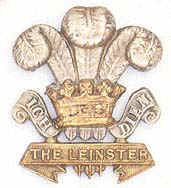Regimental Association of the Prince of Wales's Leinster Regiment (Royal Canadians)
|
|
|
|

3rd Bombay European Regiment
|
Regimental Association of the Prince of Wales's Leinster Regiment (Royal Canadians)
3rd Bombay European Regiment |
|
History of the 109th Regiment of Foot, 2nd Battalion the Prince of Wales's Leinster Regiment. 3rd Bombay European RegimentBombay (now Mumbai) was one of the islands that came to Britain as part of the marriage agreement between King Charles II and the daughter of the King of Portugal. To undertake the defence of Bombay, King Charles created the Bombay Regiment of Europeans in 1662. In 1668, Bombay was ceded to the East India Company and along with it the Regiment creating the army of the East India Company that was in effect on loan from the Crown. Between 1796 and 1798 this army was reorganised two times with the outcome that it became a formidable force. In this instance we are only focusing on the Bombay Regiment that had by 1808 grown to a strength of 26,500 comprised from 6,500 British troops and 20,000 local troops. In this early part of the 19th century locally raised cavalry also increased the effectiveness of the Bombay Regiment. The officers of the Bombay Regiment were trained in Addiscombe, Surrey, England or recruited from direct appointment. In 1853 the East India Company further increased the size of the force and created the a third infantry regiment on the 15th November 1853. The strength of the 3rd Bombay European Regiment at the time of establishment.
The 3rd Bombay European Regiment was initially stationed in Poona, a popular destination for Europeans in the rainy season and very popular with the troops. However the 'good life' was not something to continue and the dark clouds of the Indian Mutiny were on the horizon. As part of the Central India Field Force, 2nd Brigade, the 3rd Bombay departed Poona on the 1st October 1857 the objective to capture the 'rebel' stronghold Jhansi. For the early part of the campaign the 3rd Bombay spent their time at Sehore before moving on in January 1858 to Bhopal thence onto Rathghur . On the 26 January the 3rd Bombay Europeans commenced the preparation of the siege by helping with the placement of the artillery in difficult terrain. Following severe bombardment of the fort, on the 28th January the 3rd Bombay Europeans ignored the direct order of the C.O. and were the first troops to enter the besieged fort to discover their 500 strong enemy had escaped but before doing so had inflicted atrocious injury on the European women who had been caught up in the siege. On the 30th January, Sir Hugh Rose led a detachment of the 2nd Brigade, including the 3rd Bombay Europeans in pursuit of their enemy who were caught and routed at the River Beena by the 3rd Bombay Europeans and this was quickly followed by the 3rd Bombay Europeans occupying the fort at Barodia. In his report back to England, Sir Hugh Rose singled out the 3rd Bombay Europeans and their C.O. Lt. Col Liddell for praise. Fifteen names from the Regiment were mentioned in dispatches, 14 officers and one Private Davies of the 3rd Bombay European Regiment. By the 9th February the 3rd Bombay Europeans were once more heading for action marching through the jungle as part of the force to attack Garrakota. Again the 3rd Bombay were in the thick of it, fighting the sepoys who had mutinied. The sepoys, having been trained by the British, were a brave tactical force who took the fight to the 3rd Bombay Europeans who in turn battled steadfastly forcing the sepoys to retreat back into their fort. The fort was then continually bombarded with heavy shell and eventually on the 13th February Sir Hugh Rose's force was successful in causing the sepoy to abandon the fort which was entered by the 3rd Bombay Europeans early in the morning. There are a number of Internet sites that can provide background information concerning the Bombay European Regiment and the Leinsters and these are identified at the base of this page. We like to believe that the most definitive explanation of how the 3rd Bombay European Regiment became the 109th Regiment of Foot and thence the 2nd Battalion Leinster Regiment is found right here.
|
Send mail with questions or comments about this web site. to
|